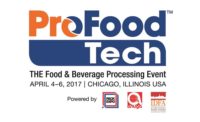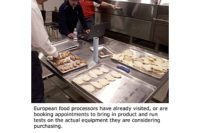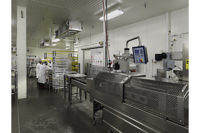How R&D Test Kitchens Perfect Food Processes

Imagine a collaboration between multiple cooking equipment manufacturers who partner in a test kitchen facility to deliver end-to-end solutions for food  processors with one goal in mind—to provide those customers with a superior process.
processors with one goal in mind—to provide those customers with a superior process.
The need for that kind of test facility has become more imperative as food processing systems become increasingly complex, requiring the integration of multiple technologies that often incorporate equipment from multiple manufacturers. By experiencing end-to-end processing solutions rather than only limited equipment demos, processors can view a complete equipment line that includes everything involved—from raw materials to packaging.
The outcome of working with this more comprehensive approach is valuable R&D, which enables processors to develop improved products as well as systems that meet other goals, such as improved product yields, food safety and shelf life.
This also provides processors a testing ground utilizing high-quality equipment from specialized manufacturers rather than just buying from turnkey manufacturers whose systems may not be the best suited solution. True collaboration as such, where multiple manufacturers consult under one roof, is rare, as each party is bidding for a limited portion of capital available, but the results are remarkably improved processes.
One such facility is the solution center at Unitherm Food Systems, Bristow, Okla. A global manufacturer of advanced cooking, pasteurizing, chilling and freezing systems, Unitherm partnered with other manufacturers to integrate all the equipment necessary to provide visiting processors with a complete production line experience.
“For companies who don’t have their own R&D facilities, Unitherm’s solution center provides access to all of the equipment and testing processes, resources that we couldn’t afford to have in-house,” says Kevin Salva, chief operating officer of Zweigles, Inc., Rochester, N.Y.
Zweigles has been producing “Old World” hot dogs, sausages and lunch meats for more than 130 years, and is currently expanding its plant and product line to include chicken, beef and pork products. As a result, Zweigles utilizes Unitherm’s test facility to evaluate various types of equipment that were needed to cook these new items, including wireless temperature probes, thermal 3D animation of airflow and burner efficiencies, vision technology for belt loading efficiency analysis and more.
“We can’t realistically set up a pilot lab or a pilot kitchen at our plant,” Salva says. “So, I think this is a great resource for large and small customers to perform real-time testing of their own products on the latest equipment.”
The Unitherm “solution center” test kitchen includes the latest continuous systems of various capacities for both protein and vegetable products, including inline smoking and browning, small footprint “spiral” ovens and continuous peeling, pasteurizing and grilling of vegetables, such as onions and peppers. The equipment is arranged in in-line configurations, so that processors can experience continuous cooking with a spiral oven, for example, and complete fry line to see how the two processes work together, providing an alternative solution through flash frying.
However, instead of a facility dedicated to one manufacturer’s products, Unitherm includes third-party “partner” suppliers’ systems and accessory equipment in a variety of configurations to provide visitors with a true end-to-end examination of various processing options. This equipment could include virtually any design required from input of raw ingredients to packaging.
“The equipment selection in our solution center encompasses machinery used in combination with our own product line,” says Adam Cowherd, Unitherm vice president of sales. “For example, we may incorporate a Grote slicer at the discharge of the oven. This slicer self-sterilizes and can be used for slicing chicken breasts or pork bellies. We’ve also introduced some new technologies such as hybrid cooking systems with Amtek microwave technology.”
In another example, Unitherm offers a former-batter-breader-fryer line using a continuous system provided by Deighton Manufacturing, UK. This system automates the preparation and frying of formed products such as chicken nuggets and fish patties.
Tools for tracking the results are also provided, which is crucial to measuring value and success.
“I think it is important to be able to actually cook on a piece of equipment using your own products and see what your results are vs. doing a pilot lab or in-house test kitchen where you’re trying to replicate the equipment and process in your own facility using the equipment you may happen to have,” Salva says. “Being able to test your products on the advanced systems should be very valuable to any company in our industry.”
Furthermore, testing on these scalable systems makes the trials more accurate in predicting future performance once installed in-house, which lends to confidence when making a capital investment.
In the case of Unitherm, its solution center provides opportunities for discussion with the process engineers and technical sales support, who assist in the equipment testing and process development for food manufacturers. In-house engineers make it possible to discuss further customization and development directly between the customer and design team and software such as Solidworks 3D provides a visual to aid in the conversation.
“The more advanced test kitchen allows food processors to outsource their R&D work in a highly efficient and scientific manner,” says Cowherd. “We focus on the visitor’s takeaway from the testing experience. We’re incorporating more tools and methods for recording data from the equipment demonstrations and product testing. This enables the visitors to compare systems and processes more efficiently, and also enhances the R&D value of the experience.”
For Zweigles, the testing addressed the characteristics of its new products and the settings and adjustments that were available on various types of equipment that enabled different output from the same system.
“We were looking at the ability to adjust the air velocity or the temperature or humidity and measure what the output was in terms of our product,” Salva says. “The testing experience is product-specific and customer-specific, so it shows you what equipment and processes you can use for whatever product you have in mind. Plus, Unitherm adds its input and experience in creating a variety of solutions. I think this would be very valuable for a company of any size.”
Looking for a reprint of this article?
From high-res PDFs to custom plaques, order your copy today!






